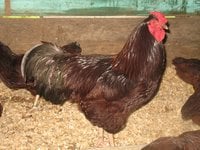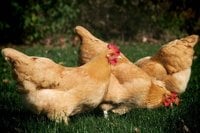That right, there is more than one type of Rhode Island and they are very distinct breeds. Reds are one of, if not the most common brown egg layer to be found. While the whites are practically unknown by comparision. So lets start with a little history before some compare and contrast of the Reds.
A highly informative history on the White type can be found here: http://albc-usa.org/cpl/rhodewhite.html Please read it as I dont care to plagerize or rehash.
Next lets cover a very real issue with Reds. This issue is the "Modern Industial/Production Red"(PR) vs. the "Heritage Red"(HR). Is there a definite difference? I think so. I would point out some key differences.
To those that would differ I would point to the original intent of the breed. This is that the Rhode Island Red is to be first a layer breed, then when hens were spent a decent meat animal could be harvested as well as a breed who's males quickly grow big enough to be a respectable table bird. In this one point of fufilling the breeds original intent I will agree there is very little difference.
Now then why I can see two different breeds.
First difference I would point out is the plumage colors. There is two shades of red to be seen. The PR was not bred for much else besides egg production and due to this the firery lusterous deep mahogany plumage that the HR still wears has given way to a lighter, duller, but still red feathered bird.
I would point out size next. The PR is a smaller bird than the HR. This does help the PR with how economical it is to feed laying hens. The PR should lay more eggs on less feed. Even if its a likely smaller egg.
Lastly, and in my opinion the clearest difference; the attitudes or disposition. The HR I have had were calm, unaggressive, nonflighty and quiet. The opposite can be said for the PR I have kept. Plainly the were annoying, mean, and a nuisance on my farm. While I had them I had a horrible feather pecking issue that turned to cannibalism. I would add that this was even while the birds were freely open to range over my lawn and the farm fields in the backyard. I removed the cannibal birds, all PR, and have not had a feather pecking issue since.
The reason for this divergance in the Rhode Island Red is soley breeder selection. The HR has been pure bred to a standard while the PR has been bred purely for economic utility. If the priorities of two flock managers differ enough it can not only create disinct lines but will eventually produce a recognizably different breed.
P.S.
Seeing as hatcheries choose to sell PR labeled as Rhode Island Red it seems of little importance that New Hampshire blood was introduced in some PR lines. Ill review the Whites on a different breed profile.
A highly informative history on the White type can be found here: http://albc-usa.org/cpl/rhodewhite.html Please read it as I dont care to plagerize or rehash.
Next lets cover a very real issue with Reds. This issue is the "Modern Industial/Production Red"(PR) vs. the "Heritage Red"(HR). Is there a definite difference? I think so. I would point out some key differences.
To those that would differ I would point to the original intent of the breed. This is that the Rhode Island Red is to be first a layer breed, then when hens were spent a decent meat animal could be harvested as well as a breed who's males quickly grow big enough to be a respectable table bird. In this one point of fufilling the breeds original intent I will agree there is very little difference.
Now then why I can see two different breeds.
First difference I would point out is the plumage colors. There is two shades of red to be seen. The PR was not bred for much else besides egg production and due to this the firery lusterous deep mahogany plumage that the HR still wears has given way to a lighter, duller, but still red feathered bird.
I would point out size next. The PR is a smaller bird than the HR. This does help the PR with how economical it is to feed laying hens. The PR should lay more eggs on less feed. Even if its a likely smaller egg.
Lastly, and in my opinion the clearest difference; the attitudes or disposition. The HR I have had were calm, unaggressive, nonflighty and quiet. The opposite can be said for the PR I have kept. Plainly the were annoying, mean, and a nuisance on my farm. While I had them I had a horrible feather pecking issue that turned to cannibalism. I would add that this was even while the birds were freely open to range over my lawn and the farm fields in the backyard. I removed the cannibal birds, all PR, and have not had a feather pecking issue since.
The reason for this divergance in the Rhode Island Red is soley breeder selection. The HR has been pure bred to a standard while the PR has been bred purely for economic utility. If the priorities of two flock managers differ enough it can not only create disinct lines but will eventually produce a recognizably different breed.
P.S.
Seeing as hatcheries choose to sell PR labeled as Rhode Island Red it seems of little importance that New Hampshire blood was introduced in some PR lines. Ill review the Whites on a different breed profile.


